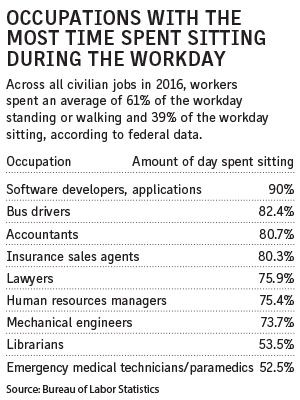Active workplaces present trade-off between worker health and safety
Reprints
With many workers spending the majority of their day sitting at a desk, some employers are encouraging employees to move during the day to improve their health. But safety experts say the trend could increase the risk of injury for workers, offsetting the health benefits.
Employers should be careful to balance the potential wellness and productivity benefits of active workstation products with the potential risks they might introduce, sources said.
A report released in March by health insurer Aetna Inc. called on employers and insurers to immediately implement efforts along with government agencies and other organizations to help tackle a global obesity problem that it said has reached pandemic levels. The report, quoting World Health Organization figures, said 13% of adults worldwide are classified as obese and nearly 40% are overweight.
Chronic health conditions and diseases linked to obesity and sedentary lifestyles have spawned the ominous mantra: “Sitting is the new smoking,” experts say.

One way employers are encouraging activity during the day is by allowing employees to use active workstation tools.
That includes exercise balls that are said to promote core muscle building, sit-stand desks that encourage a healthy change of position throughout the day and desks that include treadmills or stationary bicycles to give employees the option to burn calories while attending to emails and conference calls.
“Most companies getting in on standing desks and related products are doing so to bolster an internal wellness campaign, but this isn’t to say some aren’t getting them as simply a novelty or employment perk within a company,” said Komal Jain, founder of San Diego-based standing desk company Ergopose.
A 2016 study conducted by Texas A&M University found that employees who used desks that allowed them to transition between seated and standing positions throughout the day were about 46% more productive than those who sat throughout their entire workday. However, a 2015 study of treadmill desk use by overweight and obese office workers conducted by Oregon State University found that while average daily steps increased by more than 1,000, the study participants did not record any significant weight loss or changes in body mass index over a 12-week period.
“Treadmill desks aren’t an effective replacement for regular exercise, and the benefits of the desks may not justify the cost and other challenges that come with implementing them,” wrote John M. Schuna Jr., an assistant professor of exercise and sports science at OSU and one of the report’s authors, in a statement about the study.
In addition to questions about the benefits of active workstations, they also could introduce safety risks. Injuries sustained while using such tools would likely be compensable under workers compensation and could lead to injured workers missing work, said J. Carin Burford, a Birmingham, Alabama-based shareholder with law firm Ogletree, Deakins, Nash, Smoak & Stewart P.C.
Colorado Springs Utilities in Colorado Springs, Colorado, has deployed sit-stand desks for its employees and encourages them to alternate between sitting and standing throughout the day. Mark Hansen, manager of safety and health for the utility provider, said the company was motivated by statistics that show standing one to two hours per day can improve health.
But moving beyond standing to add aerobic activity at a workstation could lead to performance delays because the brain and body aren’t adept at splitting attention between cognitive and physical tasks, said Mr. Hansen, who is also a past president of the American Society of Safety Engineers.
“As a society, we want to cram as much into a minute as possible,” he said.
To maximize safety and benefits while minimizing risk, employers should consider several possible best practices and guidelines, including requiring employees to wear proper shoes and limiting how fast they can walk on a treadmill while working, said Ms. Burford of Ogletree. A wise first step for employers considering allowing or supplying active workstation tools is to consult with an ergonomist to evaluate the devices and make recommendations about their safe use in an office environment, she said.
Employers may also consider requiring employees to sign a waiver or obtain a doctor’s note before allowing them to use active workstation tools, although a waiver likely would not protect employers from workers comp claims related to active workstation injuries, Ms. Burford said.
Employer-provided active workstation equipment should be properly maintained as injuries resulting from improperly maintained equipment could expose employers to tort claims, Ms. Burford said.
Ms. Jain says focus is crucial for keeping workers safe while being active on the job.
“If someone is engrossed in a task while walking on a treadmill, it wouldn’t be hard to picture them losing track of their tread and misplacing a foot, which could lead to catastrophic injuries,” she said.
Read Next
-
Workstation risks not yet reflected in comp pricing
Workers compensation insurers are taking a wait-and-see approach when it comes to pricing the growing active workstation trend into their policies, said Mark Thompson, head of product for Chicago-based online small-business insurance agency Insureon.